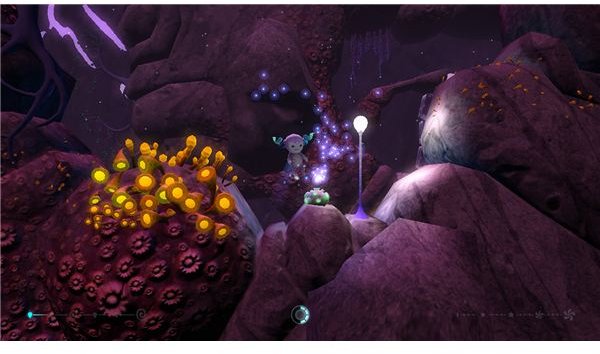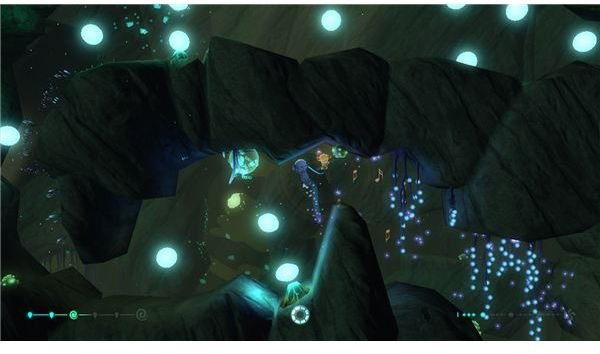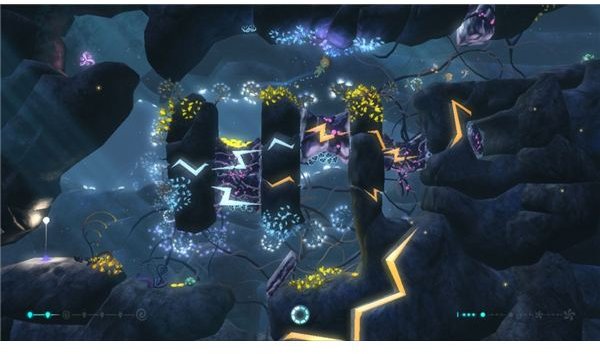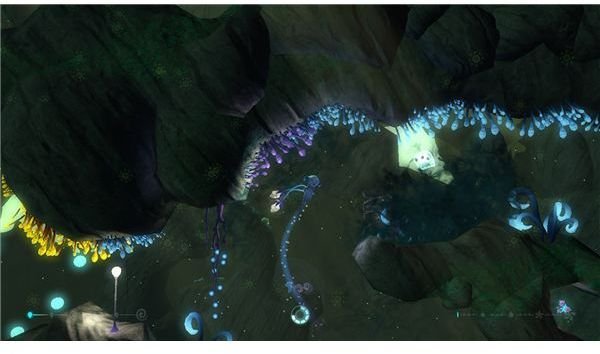The UnderGarden (XBLA) Review - Part 1 of 2

The UnderGarden - An XBLA Review
The UnderGarden is a melodious ambient platformer recently released on the Xbox Live Arcarde. In it, players are tasked with revitalising plants and fauna found throughout the games puzzle orientated levels, using pollen sacks to accomplish this task. With a minimalist ambient musicality, vibrant yet understated graphical fidelity and an onus on gentle puzzling as opposed to combat or competition, The UnderGarden stands out among its peers. Read on for a full The UnderGarden review, replete with pontification on various parts of the whole that comprises the game.
Setting of The UnderGarden (4 out of 5)

As mentioned in the opening paragraph, the player is represented by a horned-alien cipher who can be controlled through the game world, with the objective being to grow the flowers, plants and other fauna that admonish each of the levels. This purpose doesn’t necessarily have any attached exposition, although to have that frame of narrative perhaps isn’t the goal of the game, as the levels feel more like a harmonious journey than anything derivative of competition or plot. The lack of story may be facetious it alleviates rigidity in narrative and focuses on the players own experiences with the game. It is likely each person has a different outlook on why this alien is floating around the UnderGarden game world.
Across the game’s fourteen levels players will encounter a few recurring features or characters – the instrument playing monkeys or the magnetised orbs being examples – that help to color the distinct underworld setting. These same musical monkeys can be picked up by the horned-alien and used to change the coloration of fauna around them. Although there is no direct application for these characters – almost heartbreakingly, they cannot be saved from level-to-level – their place in the world is important in providing some context or pretext to the setting itself.
Graphics of The UnderGarden (5 out of 5)

While the narrative may come off as too vague or obsfucating, The UnderGarden’s aesthetics are its most forthcoming attribute, with both the sound design & graphical fidelity playing a big role in solidifying the calming atmosphere. Reinforcing or impacting the relaxed nature of the gameplay, graphics decide upon easy to distinguish landscapes in the foreground of each level design, with cool colorings derived from shades of blue or purple for the majority of the pieces involved. It is worth mentioning some camera problems are present in the game however, as a maximum zooming out will leave the player not knowing what their horned-alien friend is actually doing.
Sound In The UnderGarden (5 out of 5)
This pleasant feeling is further confounded by the ambient soundscape played during the game. Not only does it fit in with the other elements of the game, but it stands out as an individual part of it, transcending most soundtracks from other games. This is further emphasised when players encounter the aforementioned musical monkeys. As the player gets closer to them, the influence of their music playing is heard in the score. This diegetic use of music adds gravitas to the game world in the same way that a well integrated UI (Dead Space’s holographic menu) or cutscene (Alpha Protocol’s safe house TV screen).
Controls In The UnderGarden (4 out of 5)
The controls are easily mapped to the Xbox controller and have keen fidelity. Although some buttons aren’t used, this simplicity in design benefits the thematic structure of the game itself. Maneuvering the horned-alien is simple, with a contextual walk added to his natural levitation when he comes into contact with a flattened surface. The in-game puzzles are often navigated through the use of levers or pulley systems that requires the weight of various objects. These objects are found in the landscape and include reversed gravitational, normal counter weights or explosive, each being utilised fully when interacted with and laid down where needed. In addition, the player can take his monkey musician friends with him across the levels, although they won’t warp out to the game’s hub world with him.
Gameplay - The UnderGarden Review (5 out of 5)

The UnderGarden is a game with only slight restrictions or limits placed on the player. Not only does the game remove the need to embellish the player with upgrades or empowering abilities the further they go, it also admonishes the requirement to stick to stringent narrative structure or implicit story elements. The depth of the game world is mostly left to the player – which some would criticise – and lacks direction. This allows interpretation through both the mechanics and the players own disposition, which can make the entire game relativistic in its nature.
It isn’t often that a game attempts to remove the necessity for challenge or abstract competition. The UnderGarden accomplishes this by using a loose set of limits – insofar as the levels or mechanical design of the game – which allow for the player to solve problems dynamically & creatively while not worrying about the pressures of combat, adversarial constructs or enemy AI. This implicit underlying mechanic is severely lacking in the majority of video games at the moment and The UnderGarden takes a welcome departure from the trope.
Final Verdict - The UnderGarden Review (5 out of 5)

The UnderGarden showcases the need for games to incorporate things such as relativistic narrative, players inputting into the game to allow for a better experience, the use of diegetic or in-game context specific sound or ambience as well as dynamical meaning through the interpretation of its mechanics. These modicum valuables should be part of almost every successful game of today. As it stands however, the lack of creativity, ingenuity or immersive qualities displayed showcases the pressures of big game development, in as much as creating with the intent purpose on reaching the broadest audience.
A couple of interesting niggles may deter the common game player, but locked within this majestic or even trippy indie game is a beautifully crafted and well made world, pouring easy, comfortable gaming out towards its players. The UnderGarden is a game worth playing, not because it has leaderboards or achievements revolved around helping all the fauna of the universe (for those completionists who so desire), but because it uses its mechanics in a meaningful way. More important still are the implications on the player to garner some meaning from the experience in a totally insular and phenomenological fashion.
Recommendations for The Undergarden Fans
Looking for more games like The Undergarden or thematically similar but mechanically dissimilar efforts? Here are a couple of choices that many interest the budding game theorist…
